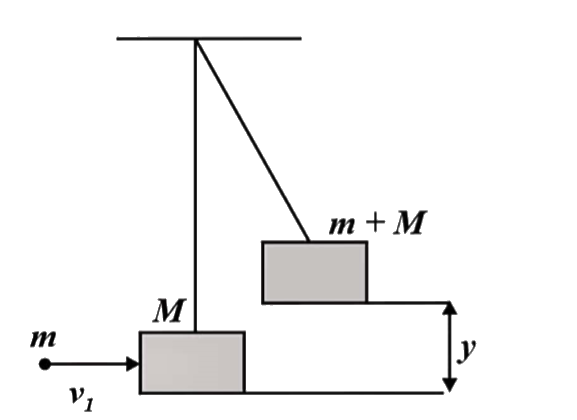A shell of mass m moving with velocity v suddenly breaks into 2 pieces. The part having mass m /4 remains stationary. The velocity of the other shell will be
u
2u
3u4
4u3
The correct Answer is:4
To solve the problem, we will apply the principle of conservation of momentum. Here are the steps to find the velocity of the other piece after the shell breaks:
1. Identify the Initial Momentum:
The initial momentum of the shell can be calculated using the formula:
Initial Momentum(Pi)=m⋅v
where m is the mass of the shell and v is its initial velocity.
2. Analyze the Final State:
After the shell breaks into two pieces:
- One piece has a mass of m4 and remains stationary, so its velocity is 0.
- The other piece has a mass of 3m4 and we will denote its velocity as V0.
3. Calculate the Final Momentum:
The final momentum of the system after the shell breaks can be expressed as:
Final Momentum(Pf)=(3m4)⋅V0+(m4)⋅0
Simplifying this gives:
Pf=3m4⋅V0
4. Apply Conservation of Momentum:
According to the law of conservation of momentum, the initial momentum must equal the final momentum:
Pi=Pf
Thus, we have:
m⋅v=3m4⋅V0
5. Solve for V0:
We can simplify the equation by canceling m from both sides (assuming m≠0):
v=34V0
Rearranging this equation to solve for V0:
V0=43v
6. Conclusion:
The velocity of the other piece (the one with mass 3m4) after the shell breaks is:
V0=43v
This velocity is in the same direction as the initial velocity v.
The initial momentum of the shell can be calculated using the formula:
Initial Momentum(Pi)=m⋅v
where m is the mass of the shell and v is its initial velocity.
After the shell breaks into two pieces:
- One piece has a mass of m4 and remains stationary, so its velocity is 0.
- The other piece has a mass of 3m4 and we will denote its velocity as V0.
The final momentum of the system after the shell breaks can be expressed as:
Final Momentum(Pf)=(3m4)⋅V0+(m4)⋅0
Simplifying this gives:
Pf=3m4⋅V0
According to the law of conservation of momentum, the initial momentum must equal the final momentum:
Pi=Pf
Thus, we have:
m⋅v=3m4⋅V0
We can simplify the equation by canceling m from both sides (assuming m≠0):
v=34V0
Rearranging this equation to solve for V0:
V0=43v
The velocity of the other piece (the one with mass 3m4) after the shell breaks is:
V0=43v
This velocity is in the same direction as the initial velocity v.
Topper's Solved these Questions
- LAWS OF MOTION BOOK - VMC MODULES ENGLISHCHAPTER - LAWS OF MOTION EXERCISE - ENABLE
50 Videos
- LAWS OF MOTION BOOK - VMC MODULES ENGLISHCHAPTER - LAWS OF MOTION EXERCISE - EFFICIENT
50 Videos
- KINEMATICS OF A PARTICLE BOOK - VMC MODULES ENGLISHCHAPTER - KINEMATICS OF A PARTICLE EXERCISE - JEE Advanced (archive)
14 Videos
- LIQUIDSBOOK - VMC MODULES ENGLISHCHAPTER - LIQUIDSEXERCISE - JEE ADVANCED (LEVEL -2)
55 Videos
Similar Questions
A shell of mass m moving with a velocity breakes up suddenly into two pieces. The pa having mass m3 remains stationary. The velocity the other part will be
View SolutionA ball of mass m1 is moving with velocity 3v. It collides head on elastically with a stationary ball of mass m2 . The velocity of both the balls become v after collision. Then the value of the ratio m2m1 is
View Solution
Knowledge Check
A body of mass m, moving with velocity μ collides elasticity with another body at rest having mass M. If the body of mass M moves with velocity V, then the velocity of the body of mass m after the impact is
Am−Mm+MμBm−Mm+MVCm+MVm+MDmu−MVmThe linear momentum of a body of mass m moving with velocity v is :
Av/mBm/vCmvD1/mv
A bullet of mass m moving with velocity υ1 strikes a suspended wooden block of mass M as shown in the figure and sticks to it. If the block rises to a height y. the initial of the bullet is

View SolutionA particle of mass 2m moving with velocity v strikes a stationary particle of mass 3m and sticks to it . The speed of the system will be
View SolutionOne projectile moving with velocity v in space, gets burst into 2 parts of masses in the ratio 1:3. The smaller part becomes stationary. What is the velocity of thhe other part?
View SolutionA particle of mass m moving with velocity v strikes a stationary particle of mass 2m and sticks to it. The speed of the system will be.
A. v2
B. 2v
C. v3
D. 3v
View SolutionA body of mass M moving with velocity V explodes into two equal parts. If one comes to rest and the other body moves with velocity v, what would be the value of v ?
View SolutionA particle of mass m1 is moving with a velocity v1 and another particle of mass m2 is moving with a velocity v2. Both of them have the same momentum but their different kinetic energies are E1 and E2 respectively. If m1>m2 then
View Solution
